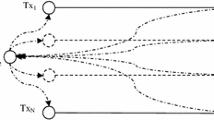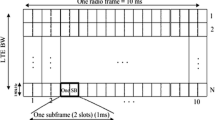Abstract
Nowadays, resource allocation is one of the major problems in the cellular networks. Due to the increasing number of autonomous heterogeneous devices in future mobile networks, a proper scheduling scheme is required to provide the adequate resources for the service flow. However, provisioning quality-of-service (QoS) for real-time applications with the constraint on transporting delay is hard to achieve without compromising other QoS parameters. In this paper, an intelligent QoS-aware bandwidth allocation solution is proposed for the uplink traffic when the channel condition is uncertain. The system is designed based on a specific maximum latency assurance for real-time applications as well as considering fairness to the throughput of non-real-time services. The scheduling system employs a channel-aware Kalman filter based interval type-2 fuzzy logic controller to estimate channel uncertainty as well as satisfying the QoS requirements for user equipment. Through simulations, the performance of the proposed system in terms of optimal bandwidth allocation, bandwidth wastage, fairness, jitters, various delays and throughputs for delay sensitive and delay tolerant services is analyzed. The numerical results show that the proposed scheme provides reliable scheduling for real-time services without harming the performance of non-real-time QoS parameters.








Similar content being viewed by others
References
Lei, L., Zhong, Z., Lin, C., & Shen, X. (2012). Operator controlled deviceto- device communications in LTE-Advanced networks. IEEE Wireless Communications, 19(3), 96–104.
Corson, M., Laroia, R., Li, J., Park, V., Richardson, T., & Tsirtsis, G. (2010). Toward proximity-aware internetworking. IEEE Wireless Communications, 17(6), 26–33.
Technical specification group services and system aspects; Feasibility study for proximity services (ProSe), Release 12. (2013). Third generation partnership project. Technical Reports on 3GPP TR 22.803 V12.2.0, June 2013.
Bhat, P., Nagata, S., Campoy, L., Berberana, I., Derham, T., Liu, G., et al. (2012). LTE-advanced: An operator perspective. IEEE Communications Magazine, 50(2), 104–114.
Baker, M. (2012). From LTE-advanced to the future. IEEE Communications Magazine, 50(2), 116–120.
Mardani, M. R., Mohebi, S., & Ghanbari, M. (2018). On the achievable rate bounds in multi-pair massive antenna relaying with correlated antennas. Wireless Networks, 24, 1–9.
Elhadad, M., El-Rabaie, M., & Abd-Elnaby, M. (2016). Resource allocation for real-time services using earliest due date mechanism in LTE networks. In Electronics, communications and computers (JEC-ECC).
Wang, Y., & Tsai, T. (2017). A pricing-aware resource scheduling framework for LTE networks. IEEE ACM Transactions on Networking, 25, 1445–1458.
Rostami, S., Arshad, K., & Rapajic, P. (2016). Energy-efficient resource allocation for LTE-A networks. IEEE Communications Letters, 20, 1429–1432.
Thayammal, M. C., & Linda, M. M. (2017). A comprehensive study on efficient resource allocation by QoS in wireless networks. ICTACT Journal on Communication Technology, 8, 1461–1464.
Oulaourf, S., Haidine, A., & Ouahmane, H. (2017). Review on radio resource allocation optimization in LTE/LTE-advanced using game theory. In Advanced communication systems and information security (ACOSIS).
Dahlman, E., Parkvall, S., Skold, J., & Beming, P. (2007). 3G evolution HSPA and LTE for mobile broad band. New York: Elsevier.
Halonen, T., Romero, J., & Melero, J. (2003). GSM, GPRS, and edge performance: Evolution towards 3G/UMTS. Hoboken: Wiley.
Boyd, S., & Vandenberghe, L. (2004). Convex optimization, Chapter 4. Cambridge: Cambridge University Press.
Wang, L. X., & Mendel, J. M. (1992). Generating fuzzy rules by learning from examples. IEEE Transactions on Systems, Man, and Cybernetics, 22(6), 1414–1427.
Mudassir, A., Akhtar, S., Kamel, H., & Javaid, N. (2016). A survey on fuzzy logic applications in wireless and mobile communication for LTE networks. In Complex, intelligent, and software intensive systems (CISIS).
Chung, W., Chang, C., & Wang, L. (2012). An intelligent priority resource allocation scheme for LTE-A downlink systems. IEEE Wireless Communications Letters, 1, 241–244.
Alsahag, A. M., Ali, B. M., Noordin, N. K., & Mohamad, H. (2014). Fair uplink bandwidth allocation and latency guarantee for mobile WiMAX using fuzzy adaptive deficit round robin. Journal of Network and Computer Applications, 39, 17–25.
Sharma, A., Kaushal, M., & Khehra, B. S. (2017). Proposal and evaluation of a fuzzy logic- driven resource allocation mechanism. International Journal of Fuzzy Systems, 19(2), 383–399.
Jammeh, E. A., Fleury, M., Wagner, C., Hagras, H., & Ghanbari, M. (2009). Interval type-2 fuzzy logic congestion control for video streaming across IP networks. IEEE Transactions on Fuzzy Systems, 17(5), 1123–1142.
Zadeh, L. A. (1965). Fuzzy sets. Information and Control, 8(3), 338–353.
Kosko, B. (1992). Neural networks and fuzzy systems: A dynamic systems approach to machine intelligence. Englewood Cliffs, NY: Prentice Hall.
Sasikala, E., & Rengarajan, N. (2015). An intelligent technique to detect jamming attack in wireless sensor networks (wsns). International Journal of Fuzzy Systems, 17(1), 76–83.
Zhang, L., Wang, Y., & Wang, Q. (2015). Adaptive fuzzy synchronization for uncertain chaotic systems with different dimensions and disturbances. International Journal of Fuzzy Systems, 17(2), 309–320.
Lin, T.-C., Huang, F.-Y., Du, Z., & Lin, Y.-C. (2015). Synchronization of fuzzy modeling chaotic time delay memristor-based chuas circuits with application to secure communication. International Journal of Fuzzy Systems, 17(2), 206–214.
Taki, M., Heshmati, M., & Omid, Y. (2016). Fuzzy-based optimized QoS-constrained resource allocation in a heterogeneous wireless network. International Journal of Fuzzy Systems, 18(6), 1131–1140.
Mardani, M. R., Mohebi, S., & Bobarshad, H. (2016). Robust uplink resource allocation in LTE networks with M2 M devices as an infrastructure of internet of things. In Future internet of things and cloud (FiCloud), 2016 IEEE 4th international conference on (pp. 186-193). IEEE.
Mendel, J. M. (2014). General type-2 fuzzy logic systems made simple: A tutorial. IEEE Transactions on Fuzzy Systems, 22(5), 1162–1182.
Liang, Q., & Mendel, J. M. (2001). MPEG VBR video traffic modeling and classification using fuzzy technique. IEEE Transactions on Fuzzy Systems, 9(1), 183–193.
Liang, Q., Karnik, N. N., & Mendel, J. M. (2000). Connection admission control in atm networks using survey-based type-2 fuzzy logic systems. IEEE Transactions on Systems, Man, and Cybernetics, Part C (Applications and Reviews), 30(3), 329–339.
Shu, H., Liang, Q., & Gao, J. (2008). Wireless sensor network lifetime analysis using interval type-2 fuzzy logic systems. IEEE Transactions on Fuzzy Systems, 16(2), 416–427.
Hagras, H. (2007). Type-2 flcs: A new generation of fuzzy controllers. IEEE Computational Intelligence Magazine, 2(1), 30–43.
Jafari, S. M., Taghipour, M., & Meybodi, M. (2011). Bandwidth allocation in WiMAX networks using reinforcement learning. World Applied Sciences Journal, 15(4), 525–531.
King, P. J., & Mamdani, E. H. (1977). The application of fuzzy control systems to industrial processes. Automatica, 13(3), 235–242.
Newell, B. (1994). An introduction to fuzzy control. In D. Driankov, H. Hellendoorn and M. Reinfrank (eds) Springer, Berlin, 1993, ISBN 3 540 56362 8, 316 pp, SWFR 97).
Jamshidi, P., Ahmad, A., & Pahl, C. (2014). Autonomic resource provisioning for cloud-based software. In Proceedings of the 9th international symposium on software engineering for adaptive and self-managing systems (pp. 95–104). ACM.
Pichfie, R. (2016). Online tests of Kalman filter consistency. International Journal of Adaptive Control and Signal Processing, 30(1), 115–124.
Atawia, R., Abou-Zeid, H., Hassanein, H. S., & Noureldin, A. (2014). Robust resource allocation for predictive video streaming under channel uncertainty. In Global communications conference (GLOBECOM), 2014 IEEE (pp. 4683–4688). IEEE.
3GPP TR 25.892. (2004). Feasibility study for OFDM for UTRAN enhancement. In 3GPP Technical Reports, June 2004.
Ali, S., Zeeshan, M. (2012). A utility based resource allocation scheme with delay scheduler for LTE service-class support. In Wireless communications and networking conference (WCNC).
Mardani, M. R., Mohebi, S., Maham, B., & Bennis, M. (2017). Delay-sensitive resource allocation for relay-aided M2 M communication over LTE-advanced networks. In 2017 IEEE symposium on computers and communications (ISCC) (pp. 1033–1038).
Ben-tal, A., & Nemirovski, A. (1999). Robust solutions of uncertain linear programs. Operations Research Letters, 25, 1–13.
Lin, Y. N., Lin, Y. D., Lai, Y. C., & Wu, C. W. (2009). Highest urgency first (huf): A latency and modulation aware bandwidth allocation algorithm for WiMAX base stations. Computer Communications, 32(2), 332–342.
Author information
Authors and Affiliations
Corresponding author
Rights and permissions
About this article
Cite this article
Mardani, M.R., Ghanbari, M. Robust resource allocation scheme under channel uncertainties for LTE-A systems. Wireless Netw 25, 1313–1325 (2019). https://doi.org/10.1007/s11276-018-1740-1
Published:
Issue Date:
DOI: https://doi.org/10.1007/s11276-018-1740-1




